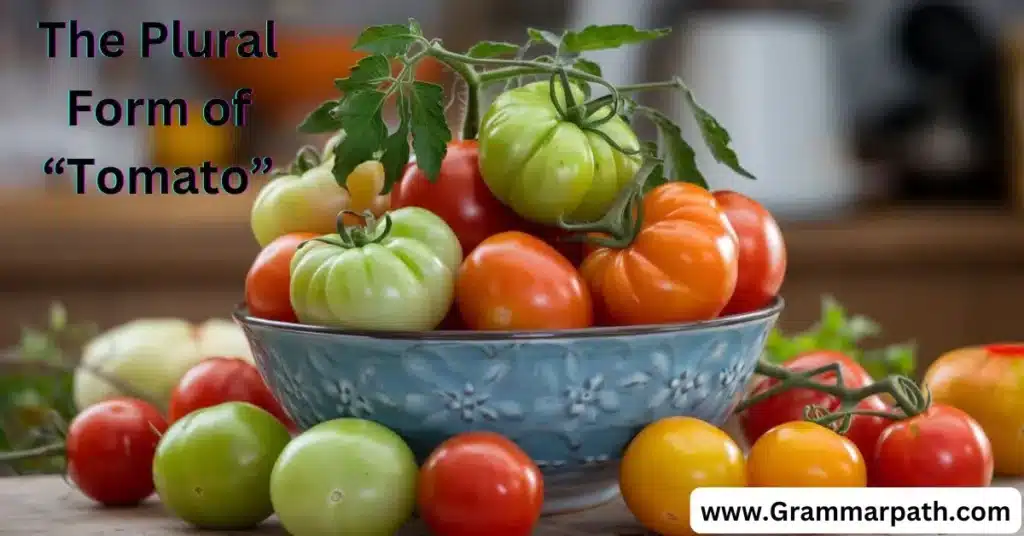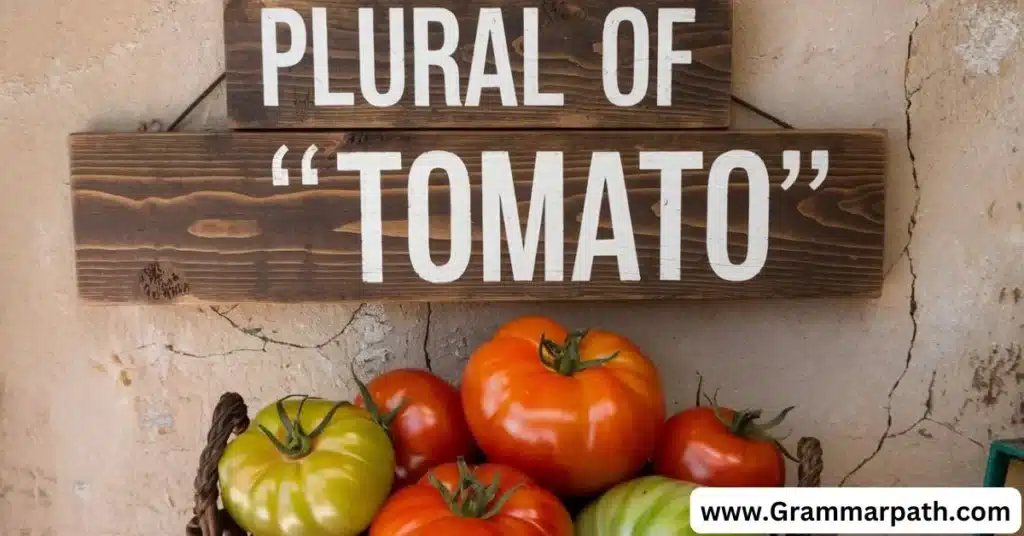In the vast world of the English language, few things can be as perplexing as pluralization. Words we use every day, like “tomato,” seem simple, yet their plural forms can stir up confusion. If you’ve ever hesitated, wondering whether it’s “tomatos” or “tomatoes,” you’re in good company. This question isn’t just a minor detail; it taps into the quirks of English spelling, the evolution of language, and even linguistic history.
The plural of tomato might look straightforward on the surface, but there’s a fascinating background that explains why “tomatoes” is the correct form and why you may occasionally see “tomatos.” This article unpacks the history, rules, and reasoning behind the pluralization of “tomato.” We’ll explore practical examples and share pro tips to clarify once and for all the right way to handle multiple tomatoes.
If you’re ready to boost your linguistic prowess and never second-guess the plural of tomato again, read on. We’ll break down the differences, give useful examples, and even throw in some fun scenarios to help solidify your understanding. Here’s everything you need to know about the plural form of “tomato” and why it’s more interesting than you might think.
What is the Plural of “Tomato”?
The plural of “tomato” is “tomatoes”. Although this might seem like a straightforward answer, understanding why it’s spelled this way requires diving into English spelling rules. Like “potato,” the word “tomato” follows a specific pattern in which words ending with a consonant followed by “-o” generally take on an “-es” ending in their plural forms. This rule helps keep pronunciation smooth and clear, a hallmark of English language patterns.
Tomato plural spelling can seem tricky, especially with modern language tendencies to simplify words. For example, it’s not uncommon to see “tomatos” as a simplified version online. However, for correct grammar, “tomatoes” is the accepted plural. This rule applies not only to common varieties like heirloom tomatoes and cherry tomatoes but also to every specific variety of tomato you might come across.
To understand this better, think of the rule as similar to other food-related nouns like “potato” or “mango.” While these may appear odd at first, they fall under a specific guideline in English grammar that standardizes their plural forms with an “-es” ending. Next time you’re writing a grocery list or sending an email about cooking supplies, you’ll know why “tomatoes” is the only grammatically correct option!
the Plural Form of “Tomato”

When determining the plural form of tomato, we can think about other foods that end in “-o” and follow similar rules. In English, some nouns ending with “-o” form plurals with “-es,” while others take on a simple “-s.” Examples like “piano” and “photo” take “pianos” and “photos,” while “potato” and “tomato” stick to “potatoes” and “tomatoes.” This distinction may feel arbitrary, but it has deep roots in English language patterns.
The difference in plural form is often due to the origins of the word itself. Words derived from Italian, Spanish, or other Romance languages tend to adopt an “-es” pluralization rule in English. Since “tomato” and “potato” both have roots in Spanish, they follow the pattern of adding “-es” to create their plural forms. English often borrows words and adapts their plural forms based on these origins, which adds to the richness (and complexity) of the language.
Pro Tip: When in doubt, remember the rule of consonant + “-o” endings. Generally, adding “-es” keeps these words grammatically correct. You’ll find that knowing this rule can make writing a breeze, especially when you encounter similar words like “hero” or “echo,” which also form plurals with “-es.”
But Why Does “Tomatos” Even Exist?
It’s common to come across “tomatos,” especially in informal contexts or online. This variant exists primarily because of a natural inclination to simplify spelling. English, as a flexible language, sees frequent shifts where words get shortened, altered, or abbreviated, particularly in digital communication. Tomato plural spelling sometimes falls victim to this trend.
For example, you might see “tomatos” used in casual texting or quick recipe notes. Since digital media often values brevity over formality, informal pluralizations like “tomatos” gain traction. However, while it’s commonly seen, it’s still incorrect according to standard grammar rules. In formal writing, “tomatoes” remains the preferred and grammatically accurate plural.
Consider this scenario: if you’re drafting an email for a catering company that needs to list ingredients, you’d write, “We require fresh tomatoes, cucumbers, and lettuce.” Using “tomatoes” here showcases correct pluralization, making the email look polished and professional. Stick with the proper form, especially in business or formal settings, to maintain credibility.
So, When is it “Tomatoes” and When is it Just Plain “Tomato”?
The difference between “tomato” and “tomatoes” depends entirely on whether you’re referring to a singular tomato or multiple tomatoes. It’s an important distinction, especially when discussing recipes or writing in contexts where precision matters. Here’s a helpful tip: use “tomato” when referring to a single fruit, and “tomatoes” when referring to more than one.
This rule is straightforward, but examples help solidify it. Imagine you’re writing a shopping list for a friend, Alex. You might say, “Pick up a tomato for the salad,” when referring to a single tomato, but if the recipe calls for more, it would become, “We need three tomatoes for the sauce.” Using “tomatoes” correctly in such scenarios improves clarity, especially for readers or listeners who depend on accurate instructions.
When speaking about specific types, such as cherry tomatoes or heirloom tomatoes, this rule doesn’t change. Each type will follow the standard pluralization, making it “heirloom tomatoes” and “cherry tomatoes,” regardless of variety. So whether you’re dealing with fresh tomatoes or a specific variety of tomatoes, you can rely on the “-es” plural to keep it correct.
Some Practical Examples of Using “Tomatoes” in Sentences

Using “tomatoes” correctly in everyday language might seem intuitive, but practice can help reinforce the rules. Here are a few examples across different scenarios:
- In an Email: “Please include two pounds of fresh tomatoes in our next delivery.” This sentence specifies the plural form needed for a bulk order.
- In a Recipe Book: “Add the diced tomatoes to the simmering pot.” The plural form is essential here to clarify that the recipe calls for more than one.
- Casual Conversation: “Do you prefer cherry tomatoes or grape tomatoes in your salad?” This question not only uses the plural correctly but also highlights specific varieties.
These examples help emphasize the correct plural form and demonstrate how “tomatoes” fits seamlessly into various contexts. No matter the setting, using the right plural form enhances understanding.
Pro Tips for Mastering Plural Forms
- Memorize the Consonant + “-o” Rule: Words like “tomato,” “potato,” and “hero” always end in “-es” for their plural forms.
- Watch for Simplified Spellings: While it’s common to see “tomatos,” remember that “tomatoes” is the correct formal spelling.
- Use Plural Forms for Clarity: Especially in professional or recipe contexts, correct pluralization eliminates confusion and makes instructions clearer.
Common English Nouns Ending in “-o” and Their Plural Forms
| Singular | Plural |
|---|---|
| Tomato | Tomatoes |
| Potato | Potatoes |
| Hero | Heroes |
| Echo | Echoes |
| Mango | Mangoes |
Key Takeaways
- Tomato pluralization follows a specific rule, adding “-es” to make “tomatoes.”
- This pattern aligns with English language rules for nouns ending in consonant + “-o.”
- In informal contexts, “tomatos” might appear, but for formal writing, “tomatoes” is correct.
Frequently Asked Question
What is the correct plural of tomato?
The correct plural of “tomato” is “tomatoes.” This follows the English rule for words ending in a consonant + “o,” where “-es” is added for pluralization.
Why does the plural of tomato have an e?
The plural of “tomato” includes an “e” because, in English, nouns ending in a consonant + “o” typically form plurals by adding “-es.” This helps maintain smooth pronunciation and aligns with similar words like “potatoes.”
What is the plural form of tomato Oxford dictionary?
According to the Oxford Dictionary, the plural form of “tomato” is “tomatoes.” This aligns with standard English grammar rules, where nouns ending in a consonant followed by “o” usually take an “-es” ending to form the plural.
What is the puzzle plural of tomato?
The plural of “tomato” in English is “tomatoes.” However, the word can sometimes be tricky because people mistakenly write “tomatos” without the “e.” The confusion comes from English rules, where most nouns ending in a consonant + “o” (like “potato” and “hero”) require adding “-es” for the correct plural form. So, while “tomato” may seem puzzling at first, the proper plural spelling is “tomatoes.”
How do you say more than one tomato?
To say more than one tomato, use the word “tomatoes.” This is the correct plural form, following the rule that nouns ending in a consonant + “o” typically add “-es” for the plural. So, for multiple tomatoes, you’d simply say, “I bought three tomatoes.”
Conclusion
The plural of “tomato” may seem simple, but it follows essential English grammar rules that add consistency to language. When in doubt, remember that “tomatoes” is the correct form, following the rule for nouns ending in consonant + “-o.”
While informal settings might lead you to see “tomatos,” sticking with “tomatoes” in formal writing shows linguistic accuracy and professionalism. So, next time you’re writing a recipe, a shopping list, or even an email, you can confidently choose the correct plural form “tomatoes.”

Emily Olivia is an experienced writer specializing in grammar and English language topics. With a passion for clarity and precision, she shares valuable insights on synonyms, grammar rules, and writing tips to help readers enhance their language skills on Grammar Path.







